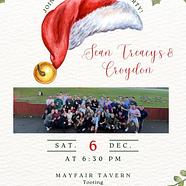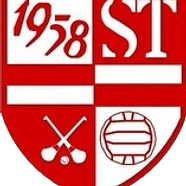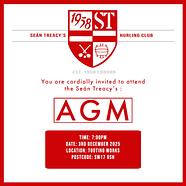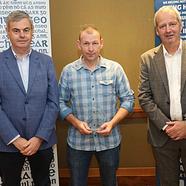Interview with Paddy Quinlan - Life President Seán Treacys
Introduction
The committee decided (pre-Covid) to conduct a series of interviews with key past members.
Paddy was a noticably visible person in the club and was local in London. We had heard many times of his interest in the club, not just from himself but others pointed us in his direction also... and they weren't wrong!
Interview by Adrian Mulchinock and Donal Henley; transcribed by Ollie O'Donoghue
When the club was founded in 1958, there was only one other hurling club in South London. That was the Emeralds who were founded in Clapham Common in 1955 and were mostly Limerick hurlers and a few Galway men. They all lived around Battersea and Clapham Junction. Patsy Hickey from Limerick and Paddy Burke from Galway were the anchor men for that club.
The first secretary of Sean Treacys was Sean O’Donnell, who had been with the Emeralds.
The first chairman was Paddy O’Brien, who had been with Brian Borus, as had Con McGrath.
Packie Hourigan won a senior club hurling medal with Brian Borus in 1955 and had been playing with them since around ’53 or ’54 until the year he joined Sean Treacys. He had played in the All-Ireland Junior Hurling Final in Limerick in 1957 – he was a corner back and he played against a centre-field man.
Paddy Ryan came afterwards and he was a leading Brian Boru man. He was from the Ragg near Thurles.
The early years in Limerick
McGrath, Hourigan and Quinlan all hailed from the Blackboy area between Cappamore and Doon in Limerick. They were born in Doon but all went to school in Cappamore.
Quinlan first went to primary school at the age of six and a half and later did two years at the Christian Brothers’ Secondary school. His friend John O’Donoghue won a scholarship for secondary school and jumped a class ahead of Quinlan. History, geography and essay-writing were his best subjects in school, while he found maths more challenging.
Greek was also taught, and his friend Jimmy Carr turned his Irish homework upside down hoping to pass it off as Greek, while the teacher scanned the work of the class quickly, for which he was severely reprimanded.
His partially blind neighbour John Moloney – a WWI veteran nicknamed the Boxer -who lived in one of the two thatched cottages nearby and set up a boxing club locally. He had the only radio around which all the neighbours would gather to hear to commentary from the hurling matches, and Quinlan would courier the battery to be charged in Cappamore, for which six pence was charged.
McGrath, Hourigan and Quinlan competed together in cross-country and underage hurling for the Blackboy. They played in the under-16 hurling league final on August 15, 1949, but were beaten by another Cappamore team - Dromalty, with the first prize a set of belts made by local harness-maker Willie Gleeson.
The team from Dromalty included the future priests Liam and Seamus Ryan, who played for Limerick in the 1955 All-Ireland Hurling Championship semi-final defeat against Wexford, having won the Munster Final.
Quinlan later caught up with Liam Ryan in the Irish Centre in London, and asked what he had done with the belts, and he said his father used them to encourage his donkey to draw milk to the creamery.
Clare beat Tipp and Cork on the way to the Munster Final in 1955, and Limerick beat Waterford, but Limerick were expected to suffer a heavy defeat in the Munster final. However, Dermot Kelly scored 1-12 for Limerick and they ended up winning easily.
Tolly Gillane, and Donal O’Grady were a formidable force in the Clare half-back line and were expected to help Clare to win an All-Ireland, however it was not to be that year.
In 1949, a month after the under-16 league final, Doon decided that they would have a parish league with medals, a luxury at the time, and the Blackboy took top honours.
The Blackboy played in 2 Parish Leagues, Doon and Cappamore. The reason being although we lived in the Doon Parish, we all went to school in Cappamore. We had a love vs. hate relationship with Cappamore.
In 1950, Doon looked like they might not field a team, when John O’Donoghue – whose brothers Jimmy and Timmy had played for Limerick - tried to affiliate a team for the Blackboy, but was not allowed as it was a townsland, so O’Donoghue captained the Doon team along with Hourigan and together they won the East Limerick championship.
Quinlan played for Doon in ’51 and collect an East Limerick minor hurling medal, having played in two matches.
He also recalls the Blackboy cross-country team, set up by Billy Shanahan, and remembers ‘running every road and jumping every ditch’ at night time. They trained barefoot in all conditions including in the snow. The pecking order was established as the race distances got longer and longer. The novice was five miles, the junior was six miles and the senior was eight miles.
Quinlan and O’Brien won the first Novice Championship in Patrickswell in ’53. Two weeks after they won the Junior Championship in Rathkeale, which Quinlan couldn’t believe, before they later went on to win the Senior Championship in Croom. Between ’53 and ’56, the Blackboy won four consecutive Senior Cross-Country Championships in Limerick.
Willie McKenna and Paddy Carmody excelled according to Quinlan, with Carmody who later went to Dublin to compete for an athletic club there.
The team was made up of farmers’ sons and farm labourers, while Quinlan’s father used to cut and sell turf and worked as a riverworker, after the local river wreaked havoc after changing course when it broke its bank in 1946, taking all the hay and turf along with it. There was work on the river for about five or six years, as there were no proper banks in place.
The club later disbanded and Quinlan upped sticks to Birmingham.
Birmingham in the 1950s
Quinlan first lived in Birmingham in ’53 in a room with Paddy Ryan, the secretary of John Mitchels hurling club. Quinlan’s sister lived in Leamington Spa, so the plan was to travel there. Quinlan and his companion got on the train at Hollyhead and one fella kept looking at them, before asking where they were travelling. He explained to them that the work was in plentiful supply in Birmingham, and that he would show them where they could get work.
His companion found work in the hospital, while Quinlan was introduced to the milkman, who took him to a beautiful house at 34 Hollywell Road in Edgbaston, the cricketing area of Birmingham.
The lady answered the door and asked him his age, before cautioning that digs would be £2.10d a week. She suggested he add an extra three years to his age – he was still yet to turn 18 – and he could get work at GKN Nettlefolds. Quinlan also remembers registering for rations at the time.
His first pay packet amounted to £6 10d. He worked alongside two Galway lads, and while the factory had a canteen, Quinlan had his own lunch and dinner at his digs in the evening.
GKN was a large engineering manufacturer of nuts, bolts and screws. Quinlan stayed working there for a few months before getting work on a building site, but frozen ground one week saw him return to work in a foundry. He met a Leitrim man Mick McGrale, a ganger man for Wimpy. He ordered Quinlan to meet him at the Bull Ring coach station in Birmingham and they travelled in separate Wimpy coaches, with McGrale going to work in Rugeley and Quinlan to Cannock, where he worked at shuttering for another few months.
The brickie told him there was work putting breeze blocks in houses that were being built for Scottish miners who were going to be working in Cannock. One morning the wall came down, and the foreman sacked Quinlan and his boss immediately on the spot.
The coach was free, and the lodging was subsidised, while the local Brummies were also given a good deal to encourage more workers in the area.
The Stores in Birmingham allowed workers to sign for a bucket or shovel, and a Waterford man Dan Murphy was the store keeper. Murphy was also a Wimpy trustee so was given a voucher to travel back to Waterford every six weeks.
Quinlan told Murphy he could get the Irish Press for him at a shop in Birmingham, for which he was grateful. In return, Murphy defended Quinlan after he heard about his sacking, and he was able to keep his job.
Quinlan then recalls heavy Aga cookers being installed in the houses, and having a soft job drawing bricks and listening to the stories of the brick layer, who had been in the war. Quinlan later got sick of the work, when it came to working on manholes in the winter months, and got a job as a bus conductor in Birmingham.
Quinlan would meet countless Irish and those from home on the number 8 route which covered the inner circle of Birmingham, and was tasked with collecting fares, although this was not always easy when the busses was full between the busiest stops.
There was a shortage of workers on the busses in Birmingham and Quinlan later found work for Willie McKenna.
London in the 1960s
Quinlan was first inspired to move to London when Brian Borus travelled to Birmingham for a match on Easter weekend and he met up with Hourigan and McGrath. Following tradition, the two teams from the previous year’s All-Ireland Finals travelled to play in exhibitions in front of tens of thousands in the old Mitcham Stadium that Easter Monday, and so Quinlan travelled to see these matches in London. He stayed with Hourigan and McGrath in Clapham Common, and later decided to move to London in ’55.
Mitcham Stadium was situated on the Mitcham side of Figge’s Marsh and also had a dog track in the middle, and Quinlan later found work in the demolition of the stadium! The two stands were sold, one to Leyton Orient and the other to Bedford Town.
The annual matches on the Easter Monday were known as the Eoin Ward Cup for the football and the Dunne, O’Sullivan and McInerney Cup for the hurling.
(Dunne and O’Sullivan were executed for the murder of Sir Henry Wilson in 1922 at Eaton Square.)
Quinlan took over as secretary for Sean Treacys in 1960 and recalls going to a Dance at the Arranmore together with McGrath, and Jimmy Hourigan and his wife.







